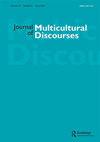Cultural Discourse Studies as culturalist approach to communication: object, objectives and tasks
IF 1.6
Q3 COMMUNICATION
引用次数: 3
Abstract
Cultural Discourse Studies (CDS), to which this journal is devoted, concerns itself with human communication, like Communication Studies (CS) in general. That is, it takes as its object of study the social interaction in which people use language and other mediums in context, purposefully and consequentially. In this view, communication is a social process which encompasses multiple elements and dimensions (e.g. language, gesture, technology, channels, time and place). As such, communication functionally constructs reality, exercises power and changes the world. And yet, different from many common forms in CS, CDS considers communication not as universal or culturally neutral, but as a global system composed of culturally diversified and competing discourses. Here discourse refers to the cultural form of communication, real or potential, of an ethnically and geopolitically characterized community (say the Chinese/ Asian/Developing/Third World, the/Western/Developed World). Culture in this context refers to the particular ways of thinking, speaking and acting, often involving concepts, norms, values, rules, language, ethnicity, religion, traditions, as well as material artefacts, that are embodied in the discursive practice of a community. Thus, culture is the defining feature of a discourse – hence cultural discourse – and of communication more generally; to study discourse and communication, then, is also to study culture. Any cultural discourse as such has its own system – discourse system. By this is meant the underlying, constitutive configuration of (a) communicative institutions (community, organization, platforms, media technology, etc. – ‘the motor system’) and (b) communicative knowhow (concepts, values, theory, information, principles, tactics, etc. – ‘the nervous system’) which combine to enable, organize and sustain a community’s discursive practice at different levels of abstraction and fields of action. It is the discursive competence of a given community and can have a profound impact on the outcome of its communicative practice. However, it should be stressed that cultural discourses are not to be taken essentialistically, as if they were homogeneous, reified or fixed. Rather, they should be understood in differential, dialectic and dynamic terms: they have dissimilarities both within and without, they are interdependent, and they are subject to change. More importantly perhaps, they are not equal to one another but must be seen in power terms: they interact with one another and consequently relations of domination, exclusion, resistance, cooperation, etc. saturate the process. For practical research purposes, CDS categorizes cultural discourse into six interlocking components, they are: Communicators, Act, Medium, Purpose, History and Culture (CAMPHAC). Specifically, Communicators imply: discursive actors as cultural organizations and members, for investigating who is (not) speaking and acting, in what position and capacity and with what characteristics (e.g. world views, ways of thinking, character, past experiences); Act: relevant verbal and non-verbal (inter)actions, for studying what is (not) said and (not) done and how, how it is responded to, and what social representation and relation result; Medium: the use of symbols, channels and other tools (e.g. specific languages, conventional and new文化话语研究作为一种文化主义的传播方式:对象、目标和任务
本期刊致力于研究的文化话语研究(CDS)与传播学(CS)一样,关注的是人类的传播。也就是说,它以人们在语境中有目的、有结果地使用语言和其他媒介的社会互动为研究对象。这种观点认为,沟通是一个包含多种元素和维度(如语言、手势、技术、渠道、时间和地点)的社会过程。因此,沟通在功能上构建了现实,行使了权力,改变了世界。然而,与许多常见的CS形式不同,CDS认为传播不是普遍的或文化中立的,而是一个由文化多样化和竞争话语组成的全球系统。在这里,话语指的是一个具有种族和地缘政治特征的社区(比如中国/亚洲/发展中/第三世界,/西方/发达世界)的交流的文化形式,无论是现实的还是潜在的。在此背景下,文化指的是特定的思维、说话和行为方式,通常涉及概念、规范、价值观、规则、语言、种族、宗教、传统以及物质人工制品,这些都体现在一个社区的话语实践中。因此,文化是话语的决定性特征——因此是文化话语——更广泛地说,是交流的决定性特征;因此,研究话语和交流也是研究文化。任何文化话语都有自己的系统——话语系统。这意味着(a)交际机构(社区、组织、平台、媒体技术等——“运动系统”)和(b)交际知识(概念、价值观、理论、信息、原则、策略等——“神经系统”)的潜在构成配置,它们结合在一起,在不同的抽象层次和行动领域实现、组织和维持一个社区的话语实践。它是一个特定群体的话语能力,可以对其交际实践的结果产生深远的影响。然而,应该强调的是,不能从本质上看待文化话语,好像它们是同质的、具体化的或固定的。相反,它们应该从差别的、辩证的和动态的角度来理解:它们内外都有差异,它们是相互依存的,它们是可以变化的。也许更重要的是,它们彼此并不平等,但必须从权力的角度来看待:它们相互作用,因此支配、排斥、抵抗、合作等关系充斥着这一过程。为了实际研究目的,CDS将文化话语分为六个环环相扣的组成部分,它们是:传播者、行为、媒介、目的、历史和文化(CAMPHAC)。具体来说,传播者意味着:作为文化组织和成员的话语行动者,用于调查谁在(不)说话和表演,处于什么位置和能力,具有什么特征(例如世界观、思维方式、性格、过去的经历);行为:相关的言语和非言语(互动)行为,用于研究说(不说)什么,做(不说)什么,如何做,如何回应,以及产生什么样的社会表征和关系;媒介:使用符号、渠道和其他工具(例如,特定的语言,传统的和新的)
本文章由计算机程序翻译,如有差异,请以英文原文为准。
求助全文
约1分钟内获得全文
求助全文

 求助内容:
求助内容: 应助结果提醒方式:
应助结果提醒方式:


